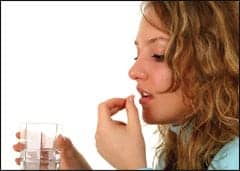 |
By the time patients finally consult a sleep physician, there is an increased chance that they have tried at least one or more over the counter (OTC) sleep aids.
Patients have many choices in OTC sleep aids these days, from traditional antihistamine-based products, such as Nytol, to numerous sleep aid supplements, such as melatonin, valerian, hops, and chamomile, none of which are regulated by the US Food and Drug Administration (FDA).
With patient self-medicating on the rise, sleep physicians need to be familiar with the various sleep aids that patients could be taking when they come in for consultation.
THE MOST COMMON CHOICE: ANTIHISTAMINE-BASED OTCS
| Stay updated on pharmaceutical trends. Subscribe to Sleep Report. |
Diphenhydramine (Benedryl, Nytol, Sleepinal, Sominex)
Diphenhydramine is the main active ingredient in the most common sleep aids available at the corner drugstore or supermarket. These products are all antihistamine-based formulas that, while initially effective, often have a carry-over effect that leaves the patient drowsy throughout the rest of the day.
Aside from daytime sleepiness, diphenhydramine’s most common side effects include dry mouth and dizziness. Men may also have trouble urinating due to a temporary enlargement of the prostate.
DOXYLAMINE (UNISOM, NYQUIL)
Doxylamine is another antihistamine-based sleep aid and can also have the same carry-over effect. The most common side effects include blurred vision, dry mouth, nausea, stomach pain, constipation, dizziness, drowsiness, problems with memory or concentration, and ringing in the ears.
Donna Arand, clinical director of the Kettering Sleep Disorders Center, Dayton, Ohio, and president of the American Insomnia Association, Chicago, cautions that these two antihistamine sleep aids and other OTC sleep aids are not stopgap measures for insomnia, but are purely short-term or for infrequent use.
Arand says, “Persons with very occasional insomnia may find benefit with using one of these OTC sleep aids, but repeated use is not recommended. They can lose effectiveness, and if the problem with insomnia is chronic, you’re much better off going to sleep specialists and pursuing effective treatment that’s a long-term solution.”
Bob Whitman, PhD, director of the Sleep Disorders Center in the University of Kansas Hospital, Kansas City, says that when patients come into the office who have tried these commercial antihistamine-type sleep aids, he generally advises that they stop taking them.
“We try to get those patients off the medications before we actually do anything with them,” says Whitman. “Otherwise, with the [carry-over] sleepiness associated with these sleep aids, it’s hard to find out what’s really going on.”
HERBAL OTC SLEEP AIDS
Because of the increasing popularity of herbal remedies for sleep and many other ailments, the National Institutes of Health (NIH), Bethesda, Md, established the National Center for Complementary and Alternative Medicine (NCCAM) to research the effectiveness of herbal treatments.
A national survey conducted by NCCAM scientists and published in the Archives of Internal Medicine in 2006 reported that 4.5% of Americans who suffer from insomnia used some form of herbal therapy.1
The AASM’s position paper on OTC sleep aids includes a review of peer-reviewed studies of herbal supplements and recommendations (see sidebar). The AASM’s general conclusions were: “There is only limited scientific evidence to show that herbal supplements are effective sleep aids. Because these products may be marketed and sold without FDA approval and may involve dangerous side effects or adverse drug interactions, they should be taken only if approved by a physician.”2
In addition, the AASM’s review of studies, authored by Meoli et al, concluded, “Sparse or no scientific data were found to support the efficacy of most products as hypnotics, including chamomile and St. John’s wort. There is preliminary but conflicting evidence suggesting Valerian officinalis L. and first-generation histamine-1-receptor antagonists have efficacy as mild hypnotics over short-term use. There are significant potential risks associated with the use of Jamaican dogwood, kava kava, alcohol, and l-tryptophan. Physicians may find this information useful in counseling their patients.”3
Nevertheless, some herbal sleep aids continue to be investigated and, in some cases, incorporated into conventional sleep medicine:
- Although not generally utilized for insomnia, melatonin is one herbal supplement that is accepted by the AASM practice parameters for use with certain circadian rhythm disorders.4,5
- The NCCAM has recently completed a phase 2 clinical trial using valerian as an alternative sleep aid for adults 55 to 80 years old. However, the results have yet to be published.6
- Chamomile tea is also used by some physicians in the context of improving sleep hygiene.
The following is a list of the most common herbal sleep aids that insomnia patients may have tried—or are still utilizing.
Chamomile Tea
In America, chamomile tea is generally derived from the German variety of the chamomile plant. The NCCAM has performed no clinical trials related to chamomile tea and sleep conditions.
Chamomile tea has long been used by herbalists for relaxation and reducing anxiety, as well as other non-sleep-related conditions. If for no other reason than this reputation, some sleep physicians use the tea as part of their sleep hygiene recommendations.
Whitman says, “We do, as part of sleep hygiene, sometimes recommend that patients take things like chamomile tea. But I think it’s just something to help you to relax more than something that really helps you to go to sleep.”
According to the NCCAM, there are infrequent reports of allergic reactions to chamomile, including skin rashes, throat swelling, shortness of breath, and anaphylaxis. These cases appear more often in patients who are allergic to related plants in the daisy family.7
Humulus lupulus (Hops)
Humulus lupulus, most commonly referred to as “hops,” has a long history of being studied as a sedative. As far back as the 1930s, researchers have tested the sedation qualities of hops on animals, from frogs to pigeons to rats. A full list of these studies and summary of outcomes can be found in an NIH/University of Chicago review paper published in 2007 by Chadwick et al.8
Despite this extensive research, it is still unclear whether hops may have a sedative effect in humans—although it appears to be effective in some animals. Part of the reason for this uncertainty is that scientists have yet to identify the active ingredient in hops that may cause sedation.
Melatonin
In terms of sleep medicine, melatonin is perhaps one of the most mainstream of herbal remedies. As mentioned previously, the AASM has included melatonin as part of its practice parameters for use with certain circadian rhythm disorders.4,5
However, melatonin is still unregulated and inconsistent in its herbal supplement form. Arand says, “There isn’t a lot of control when you buy things over the counter in terms of regulating the consistency, and so the research on it doesn’t show superstrong effects for insomnia, but every once in a while, patients do benefit from it.”
Melatonin may have side effects in rare instances. According to the Agency for Healthcare Research and Quality (AHRQ), a division of the Department of Health and Human Services, the most commonly reported adverse effects of melatonin were nausea, headache, and dizziness.9
Valerian (Valeriana officinalis)
Valerian is another herbal remedy that is gaining attention as a natural OTC sleep aid. Its use can be traced to Greco-Roman times as a sedative and antianxiety remedy.
While many studies have been performed with valerian and show that it has promise as a sleep aid for short 4- to 6-week treatment periods, the NIH currently views valerian’s effectiveness as being inconclusive.10
However, the NCCAM recently concluded an 8-week phase 2 clinical trial with valerian, but as of this writing, the results have not been published.6
The NCCAM lists some mild possible side effects for valerian, including headaches, dizziness, upset stomach, and, like antihistamine compounds, tiredness in the morning after its use.
INTERACTING WITH PATIENTS WHO USE OTCS
Both Arand and Whitman say that they will not dismiss OTC medications out of hand for patients if the remedies are working or the patients want to try them, but feel that all OTCs, whether natural-based or manufactured, are short-term or intermittent solutions.
Whitman says, “We don’t push any kind of sleep aids as long-term [remedies]. We tell our patients, ‘Let’s work on behavioral techniques and cognitive thinking and hygiene issues, and really try to use medications short-term.’ So we would tell them to use a sleep aid only when they really need to get a good night’s sleep, versus taking it every night.” Whitman also stresses that he prefers prescription sleep aids because they have fewer side effects like daytime sleepiness.
In terms of the dosing of OTCs, Arand strongly recommends patients start with the minimum dosage suggested by the manufacturer, regardless of whether the product is natural.
“You want to see what the minimum dose [is that] one can use to get effectiveness,” she says. “Certainly, when you start increasing doses of anything, you can get side effects, and most side effects are dose related.”
Of course, sleep physicians will not even be able to discuss these medications with patients if they do not seek treatment.
Whitman sees the trend of patients self-medicating themselves only growing. He says, “I think we’re going to continue to rely on those kinds of medications. One of the main reasons is that they’re very inexpensive compared to prescription medications, and a lot of people with insomnia really don’t seek help unless they’re extremely bad, or they go to a physician and complain and then the physician refers them to a sleep specialist. Otherwise, they kind of just treat themselves.”
Tor Valenza is a staff writer for Sleep Review. He can be reached at [email protected].
REFERENCES
- Pearson NJ, Johnson LL, Nahin RL. Insomnia, trouble sleeping, and complementary and alternative medicine. Analysis of the 2002 national health interview survey data. Arch Intern Med. 2006;166:1775-1782.
- http://www.eurekalert.org/pub_releases/2006-12/aaos-aps120706.php. Accessed September 4, 2008.
- Meolie [sic] AL, Rosen C, Kristo D; Clinical Practice Review Committee of the American Academy of Sleep Medicine. Oral nonprescription treatment for insomnia: an evaluation of products with limited evidence. J Clin Sleep Med. 2005;1(2):173-187.
- Morgenthaler TI, Lee-Chiong T, Alessi C. Practice parameters for the clinical evaluation and treatment of circadian rhythm sleep disorders. Sleep. 2007;30:1445-1459.
- http://www.aasmnet.org/Articles.aspx?id=623. Accessed September 4, 2008.
- http://www.clinicaltrials.gov/ct/show/NCT00097604?order=6. Accessed September 4, 2008.
- http://nccam.nih.gov/health/chamomile/. Accessed September 14, 2008.
- Chadwick LR, Pauli, GF, Farnsworth NR. The pharmacognosy of Humulus lupulus L. (hops) with an emphasis on estrogenic properties. Phytomedicine. 2006;13(1-2): 119–131. Epub July 1, 2005.
- http://www.ahrq.gov/clinic/epcsums/melatsum.htm. Accessed September 4, 2008.
- http://www.ods.od.nih.gov/factsheets/valerian.asp. Accessed September 4, 2008.




